Life Support in Space - Closed Systems
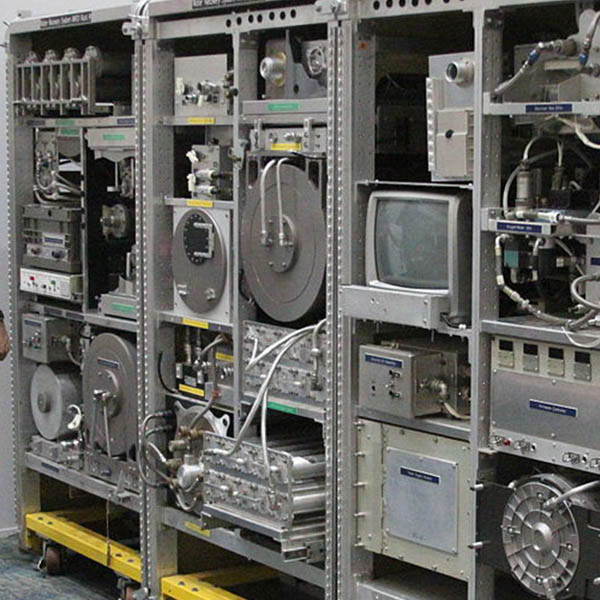
NASA Environmental Control and Life Support System (James E. Scarborough, Wikimedia Commons)

NASA Environmental Control and Life Support System (James E. Scarborough, Wikimedia Commons)
How does this align with my curriculum?
Learn how astronauts survive in the International Space Station.
Life Support in Space: Working Toward a Closed System
People, like many other living things, need air, water, and food to survive. On Earth, different parts of provide for these needs. Plants keep our air breathable by adding oxygen to the atmosphere and removing carbon dioxide. Lakes, rivers and groundwater provide our drinking water. Soil feeds the plants we harvest and eat.
The Earth is essentially a when it comes to . This means that matter does not travel back and forth between space and the Earth. All matter is recycled within our global ecosystem. The only exception to this is the few meteorites and space dust that make it down to Earth.
The orbits Earth around 400 kilometres above our heads. Astronauts on the ISS need air, water and food. But there are no ecosystems in space to provide these things. Instead, astronauts rely on the ISS life support systems to manage their air, water and waste. But what about food? Unlike in science fiction, the ISS does not provide the food. All food on the ISS is sent from Earth. This means the ISS is an open system because it is dependent on Earth for full life support.
NASA’s Environmental Control and Life Support System
Aboard the ISS, NASA’s Environmental Control and Life Support System (ECLSS) does the work of keeping astronauts alive. The ECLSS is a system of interconnected and interdependent machines. Together, they provide breathable air and drinking water for astronauts on the ISS. Machines built by the Russian Federal Space Agency (Roscosmos) also provide some life support.
Below you can see a working replica of the ECLSS at the Marshall Space Flight Centre in the United States. From left to right you can see the different modules including the shower, waste management system, 2 Water Recovery Systems (WRS), and the Oxygen Generation System (OGS).
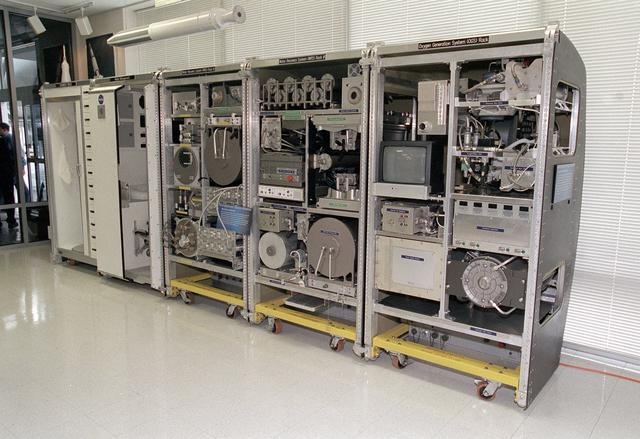
Image - Text Version
Shown is a colour photograph of a working replica of the ECLSS.
Five wheeled modules sit side by side on the floor. Each is about the size and shape of a double refrigerator. The far left module has a curtained front. This is the shower. Beside it is the waste management system. This has a closed white front panel. Beside this are two water recovery systems. They do not have front panels so we can see the devices and wiring inside, which is an assortment of different metallic shapes and sizes. The final module on the far right is the oxygen generation system. This has a similar look to the water recovery modules.
Air on the ISS
Just like on Earth, astronauts living on the ISS take in oxygen and release carbon dioxide when they breathe. However, the air they breathe needs to always contain the right amount of oxygen and carbon dioxide (CO2).
Removing CO2
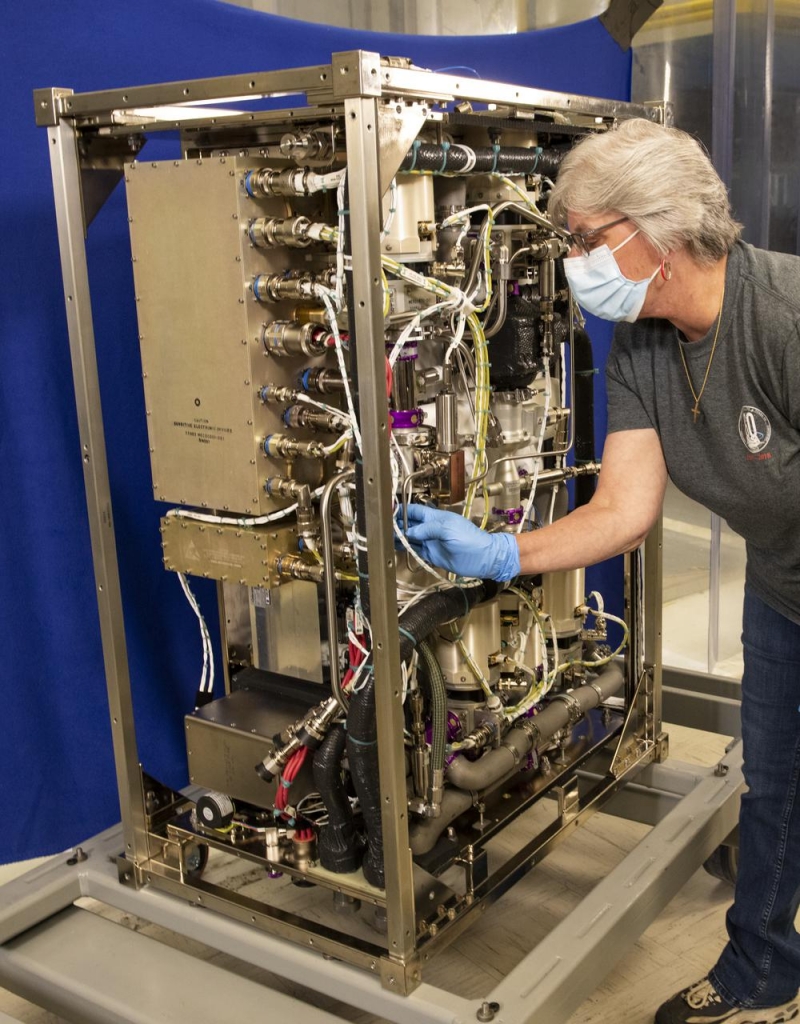
Image - Text Version
Shown is a colour photograph of a flight demonstration model of a new carbon dioxide scrubber along with an older female NASA employee. The scrubber unit has a metal frame that appears to be around 1 metre by 2 metres by 2 metres. Within the frame are many components connected by wires and numerous tubes. The employee looks to be inspecting a piece of tubing.
Removing carbon dioxide from the air is a process called or carbon scrubbing.The excess CO2 is removed using machines called scrubbers. Similar to the filters you would have in a fish tank, the scrubbers contain filters. The filters contain a called zeolite, which easily binds to CO2 and removes it from the air.
Did you know?
Using zeolites to remove CO2 is also being studied on Earth. Scientists hope it could help in reducing CO2 from Earth’s atmosphere.
The waste carbon dioxide from the scrubbers used to be sent off, also known as vented, into space. This was done until 2012, when the Carbon Dioxide Reduction System, also called the Sabatier System, was added to the ECLSS. This system uses waste carbon dioxide and hydrogen gases to make water. Methane gas is a second product of the Sabatier reaction. People cannot breathe methane gas, so it is vented into space.
Adding Oxygen
Both the Russian and American environmental systems have machines for making oxygen gas. The machines make oxygen by separating liquid water into hydrogen and oxygen gas, a process called water electrolysis. It does this using electricity from the ISS solar panels. However, this system is not efficient enough to provide oxygen for a full crew. Until they have a machine that can do this, tanks of oxygen must be sent up to the ISS from Earth on resupply vehicles. The ISS is also stocked with special emergency candles that release oxygen when they are burned.
You might wonder why the ISS doesn’t use plants to create the oxygen astronauts need. This is because the ISS is pretty limited in space and the electrolysis process is more compact and efficient than plants. However, scientists are looking to improve this efficiency as we won’t be able to send oxygen to Mars. Growing plants can also result in the best of byproducts: food!
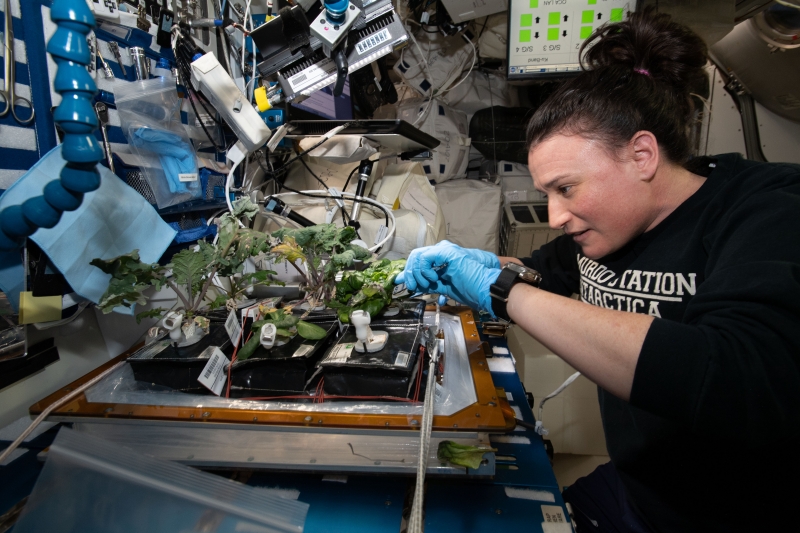
Image - Text Version
Shown is a colour photograph of a female astronaut on the ISS snipping off a piece of plant. The astronaut is carefully pulling the leaf off a tiny plant growing in a small specially designed plant growth system called Veggie. The plants were being harvested in time for a special Thanksgiving meal.
Other Air Quality Concerns
Air quality is not only about oxygen and CO2. Many other gases are also found in air. For instance, trace amounts of gases can be slowly emitted by different materials. These gases are often colorless and odorless but still toxic and need to be removed. can also grow and spread when is high. The air systems also control humidity and can filter out microorganisms that would otherwise multiply and cause illnesses.
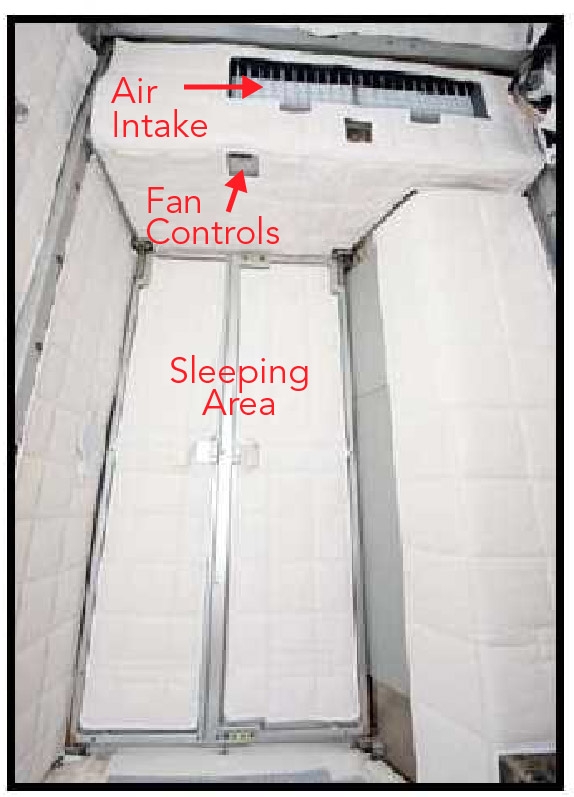
Image - Text Version
Shown is a colour photograph of an astronaut crew quarters module on the ISS.
The module looks a lot like the interior of a closet without any doors on it. The entire area is covered in white acoustic padding to dampen noise from the space station equipment. At the centre of the image is where the astronaut would sleep. This is labelled as the sleeping area. Above this is a white, rectangular unit that has a grill on the front. An arrow pointing to the grill identifies this as the fan intake. Just under the unit is a small open panel with knobs. An arrow pointing to this identifies it as the controls for the fan.
Have you ever been in a room that you thought felt “stuffy”? This was probably because it did not have good ventilation. Ventilation helps to keep air feeling fresh. On Earth, air moves naturally due to convection. Convection is when warmer air moves up and colder air moves down as a result of gravity. Without the gravity to do this, the air would not move. This would leave the air feeling stale or stuffy.
Water on the ISS
The ECLSS is able to recycle around 90% of the water used by astronauts. The recycled water is not drinkable right away. It must first be purified so it can be used for drinking. The Water Processor Assembly collects water from the Sabatier System. It also collects used water from washing, water vapour in the air from sweat, and even urine. The Water Processor Assembly produces clean water for drinking, meal preparation, hand washing and showering. This water is also used to make oxygen production in the Oxygen Generating Assembly.
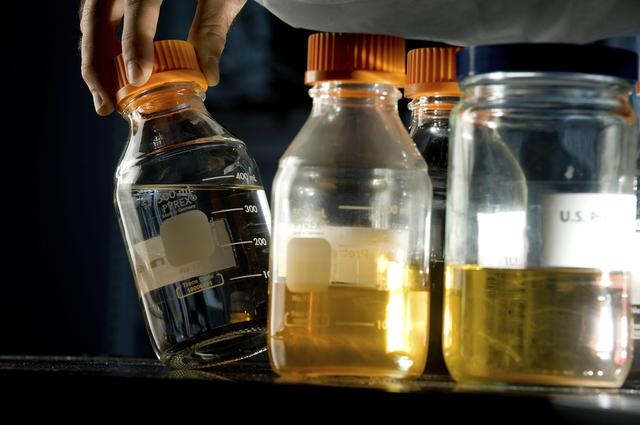
Image - Text Version
Shown is a colour photograph of bottles of liquids and a dark-skinned hand within a white sleeve.
Four glass graduated lab bottles with lids are visible. Each contains some pale yellow coloured liquid. The hand is tipping the bottle on the far left slightly to the left as if the person is trying to get a better look at the bottle's contents.
Did you know?
You might think recycling urine is somewhat gross, but water produced with the Sabatier system is 100% pure water. On Earth, even the best filtration system cannot achieve this!
Even with the best recycling, there still is not enough water for astronauts. This means that some water must be sent from Earth. In order to avoid this in the future, NASA is working to improve the ECLSS so that the air and water systems work together. This way they would work as a closed loop. Air and water could be 100% recycled giving astronauts all of the air and water they need.
Did you know?
The Russian Condensate Water Processor reclaims water vapour from the air on the ISS. It does not recycle urine like the ECLSS.
Food on the ISS
Everything astronauts eat on the ISS is sent from Earth. This makes the ISS an open system. Make sure you read our article “Space Food: Feeding Astronauts On The Iss And Beyond” to learn more about what astronauts eat on the space station.
Waste on the ISS
Solid waste on the ISS includes trash like packaging, containers, plastic bags, hygiene wipes, and used clothing, and waste. All waste is collected and stored. Later it is put into a cargo vehicle after it has delivered its cargo from Earth. When the waste-filled spacecraft re-enters Earth’s atmosphere, everything, including the vehicle, burns up. Waste management is an open system on the ISS because all waste is sent back out of the space station.
NASA is trying to reduce solid waste on the ISS by using less packaging. They are also developing ways to reuse packaging in space. For example, some packaging could be used to build shelters by using it as-is or melting it into tiles. This will be important for future long-term missions, like going to Mars.
A Fully Closed Life Support System?
The European Space Agency is coordinating an international research project called the Micro-Ecological Life Support System Alternative, or MELiSSA. The goal of the project is to create a completely closed life support system that could be used for space travel. MELiSSA is an artificial modelled on an ecosystem. The MELiSSA system would contain living plants and algae. These would use the nutrients from human waste together with carbon dioxide and oxygen to grow. MELiSSA isn’t quite ready for the ISS, but early results are promising.
Did you know?
A team of Canadian scientists from the University of Guelph is one of the international partners in MELiSSA. Researchers there have a lot of know-how about growing plants in closed environments.
Long-term space missions are on the horizon, which makes the idea of the 3Rs - Reduce, Reuse, Recycle - a must. Closed ecosystems will be an important part of long duration missions to places like Mars.
Learn More
Space Station Live: Environmental Control and Life Support System (2014) NASA
This video (3:41 min.) explores how the ECLSS recycles air and water, and how it is the foundation of life support for future Mars missions.
Breathe deep: How the ISS keeps astronauts alive (2015) CNET
This article explains how oxygen is made and recycled on the ISS.
Water Recycling on the ISS (2013) Canadian Space Agency
In this video (1:52 min.) Canadian astronaut Chris Hadfield demonstrates water recovery and recycling on the ISS.
Chris Hadfield demonstrates how astronauts wash their hands in zero-g (2013) Canadian Space Agency
In this video (1:45 min.) Canadian astronaut Chris Hadfield shows us how to wash your hands on the ISS.
Space Station Live: A First for Space Lettuce (2015) NASA Johnson
In this video (5:29 min.), Dr. Gioia Massa discusses the Veggie project and shows astronauts growing the first lettuce on the ISS.
NASA Just Sent a New $23 Million Space Toilet to the International Space Station (2020)
In this article, learn about the exciting new toilet that is being tested for deep space missions.
References
Astrobiology Magazine (2015). An Ecosystem in a Box.
Broyan, J.L. (2010). International Space Station Crew Quarters Ventilation and Acoustic Design Implementation. American Institute of Aeronautics and Astronautics. Retrieved from https://ntrs.nasa.gov/api/citations/20100017014/downloads/20100017014.pdf
Carrasquillo, R. (2013) ISS Environmental Control and Life Support System (ECLSS) Future Development for Exploration. 2nd Annual ISS Research and Development Conference.
European Space Agency (n.d.). MELiSSA: Targets and Scientific Domains.
NASA (2015). Meals Ready to Eat: Expedition 44 Crew Members Sample Leafy Greens Grown on Space Station.
NASA (n.d.). Veggie. NASA Facts.